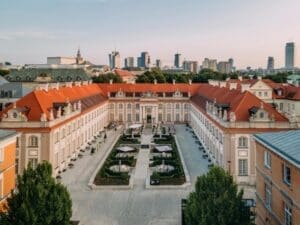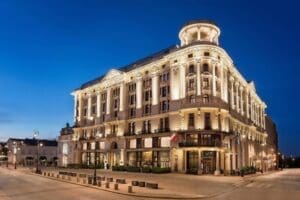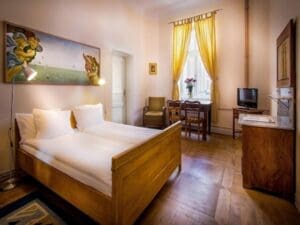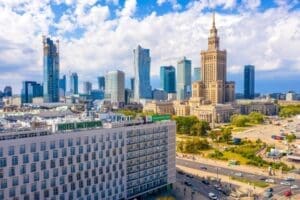We list the best hotels in Warsaw as recommended by travel experts from CNN, Lonely Planet, Frommer’s, Fodor’s, New York Times and more. All hotel recommendations have been referenced with customer reviews, and we only listed places that have at least a 4 out of 5-star customer review rating.
Best cheap hotel in Warsaw: Hit Apartments
Best boutique hotel in Warsaw: H15 Boutique Hotel
Best luxury hotel in Warsaw: Hotel Bristol
Best hostel in Warsaw: Oki Doki Hostel




“It’s now possible to sleep in a Baroque palace just steps from Warsaw’s Old Town thanks to Hotel Verte composing the Branicki and Szaniawski palaces. Each of the 94 playful bedrooms highlights 18th-century features, while Chef Maciej Majewski keeps patrons entertained and well-nourished at KUK’s neo-bistro.”

“The latest in the expanding empire of the Polish Puro group and its first foray into Poland’s capital, Puro Warsaw is a sleek, design-savvy hotel with 148 rooms, a leafy roof-top terrace and the excellent, Italian themed, Magari Restaurant which spills outside on sunny days. Popular with a young but discerning crowd.”

“Still sitting pretty on the Royal Mile, its charms extend to a swanky subterranean spa, the marble-decked Long Bar (sample the ginger-laced Warsaw sling) and a museum-worthy collection of modern and contemporary Polish art, which you can tour with the dedicated art concierge.”

“Opened in 1901 by the Polish composer and pianist Ignacy Paderewski, the grand, neo-Renaissance Hotel Bristol has hosted Pablo Picasso, Marlene Dietrich and Sophia Loren.”
Featured in New York Times’ 36 Hours in Warsaw.

“This boutique, luxury establishment is an oasis within the busy capital. With a superb location at the north end of the Old Town, the hotel is a remodeled 18th-century palace that’s rich in history, including a stint as the quarters of the U.S. Embassy in the 1950s.”

“A perfect location, central but quiet, is just the first of many qualities to recommend this B&B that is locally owned and run as an honest and ethical business. The rooms are furnished with a well-balanced mix of antiques and modern comforts.”

“This apartotel offers more space than a traditional hotel, professional and discreet service, and a kitchenette in even the smallest standard rooms. Suites are tastefully and comprehensively furnished and designed, and all include a kitchenette, so what you’re really getting is your own, elegant mini-apartment in the center of town.”

“Warsaw’s first skyscraper, dating back to 1931, was reborn as one of the city’s most distinguished hotels in 2018. Every one of the 142 voluminous rooms at Hotel Warszawa is tastefully outfitted in wood and marble.”

“The first restaurant-led hotel in Warsaw brims with a new energy not seen before on its streets. Nobu Warsaw sets its focus firmly on the future as opposed to paying homage to the capital’s past; it is invigoratingly different.”

“You couldn’t ask for a handier location for exploring the city centre, standing opposite Warsaw’s Palace of Culture and Science. The heart of the hotel is its Metro Jazz Bar & Bistro, which has all your day-to-night dining and drinking options covered.”
Recommended by:
Travel+Leisure
Recommended by:
Telegraph
Recommended by:
The Times, Telegraph
Recommended by:
New York Times, Forbes, Frommers
Recommended by:
Fodors, Telegraph
Recommended by:
Fodors
Recommended by:
Fodors, The Times, Telegraph
Recommended by:
Travel+Leisure
Recommended by:
CN Traveler, Telegraph
Recommended by:
The Times
For 3-star hotels, the average rate is around $60 per night. If you're looking for a 4-star hotel, then the rates are around $95 per night. The average rate for a 5-star hotel in Warsaw is around $200 per night.
The best areas to stay in Warsaw are: Śródmieście, Stare Miasto, Wola, Praga-Północ or Mokotów. Please read our extensive guide about where to stay in Warsaw. It offers a great overview about each area, including the museums, attractions and other things, as well as the best place to stay in each area.
If you fancy a bit of extravagance but prefer to stay away from the well-known chain hotels, then H15 Boutique Hotel is an excellent option for you. This hotel has been very well-reviewed by travelers and experts alike. For more information on other cool hotels, take a look at our list of the best boutique hotels in Warsaw.
If money isn't a problem and you're looking for a luxury hotel in Warsaw, then go for Hotel Bristol. The hotel offers excellent service, it's in a top location, it has been rated very highly by previous guests and renowned travel critics have recommended it.
Also check out our list of the best luxury hotels in Warsaw, it's a manually curated list of the most exclusive 5-star hotels in the city.
If you are on the hunt for an affordable hotel, then you should consider reserving Hit Apartments. It is a great option for those on a budget, as it provides good value for your money. The hotel is in a suitable location, and travel experts and guests have given it their approval. Also check out our list of the best cheap hotels in Warsaw.
If you're looking for a well-priced private room or comfy dorm in Warsaw, Oki Doki Hostel is worth a look. The hostel has been highly praised by backpackers. Additionally, we have compiled a shortlist of the best hostels in Warsaw based on thousands of reviews from backpackers.
Warsaw, Poland’s vibrant capital, has emerged from a turbulent history as one of Europe’s most dynamic and resilient cities. The city’s story is one of remarkable rebirth, particularly following the devastation of World War II, when approximately 85% of its buildings were destroyed.
The city’s origins date back to the 13th century, but it truly flourished after becoming the capital of Poland in 1596, when King Sigismund III Vasa moved his court from Kraków. Under his reign and throughout the following centuries, Warsaw developed into an important cultural and political center, with magnificent palaces and churches built in various architectural styles.
The Old Town (Stare Miasto) stands as a testament to Polish determination and pride. Almost completely destroyed during WWII, it was meticulously reconstructed using pre-war photographs, architectural drawings, and even paintings by the Italian artist Bernardo Bellotto. This extraordinary reconstruction effort earned the Old Town a place on UNESCO’s World Heritage list. Today, visitors can wander through its charming cobblestone streets, admiring the colorful townhouses and experiencing the lively Market Square (Rynek Starego Miasta).
The Royal Castle, once home to Polish monarchs and now a museum, showcases the grandeur of Poland’s royal history. Its State Rooms are filled with period furniture, artwork, and the famous Canaletto Room, featuring 23 views of Warsaw painted by Bernardo Bellotto. Nearby, the Royal Route (Trakt Królewski) stretches south from the castle through the elegant Krakowskie Przedmieście and Nowy Świat streets, lined with historic buildings, churches, and palaces.
Modern Warsaw offers an intriguing contrast to its historical sites. The Palace of Culture and Science, a controversial gift from Stalin, remains the city’s tallest building and a prominent landmark. While some view it as a reminder of Soviet dominance, others appreciate its architectural significance and the panoramic views from its observation deck.
The city’s museums powerfully document Poland’s history. The Warsaw Uprising Museum provides a moving tribute to the 1944 uprising against Nazi occupation, while POLIN Museum of the History of Polish Jews celebrates a millennium of Jewish life in Poland. The Copernicus Science Centre offers interactive exhibits that make science accessible and entertaining for visitors of all ages.
Warsaw’s green spaces provide peaceful retreats from urban life. The Royal Łazienki Park, the city’s largest park, features the elegant Palace on the Isle, amphitheater, and famous Chopin Monument, where free piano concerts are held during summer Sundays. The Saxon Garden (Ogród Saski), one of Europe’s first public parks, offers beautiful fountains and the Tomb of the Unknown Soldier.
The city’s culinary scene has exploded in recent years, from traditional milk bars (bar mleczny) serving Polish comfort food to Michelin-starred restaurants. The Praga district, on the east bank of the Vistula River, has transformed from an industrial area into a creative hub, with art galleries, studios, and alternative culture venues.
Warsaw’s appeal lies in its successful blend of history and modernity, resilience and innovation. It’s a city that honors its past while embracing the future, offering visitors an authentic experience of both traditional and contemporary Poland. Whether exploring its reconstructed Old Town, enjoying cultural events, or discovering its modern face, Warsaw provides a unique perspective on European history and urban renewal.
Get to know the city even better by reading our guide about the best areas to stay in Warsaw.
If you like our list of the best hotels and accommodations in Warsaw, then you should also check out our selection of recommended hotels in Kraków or the best hotels in Helsinki.